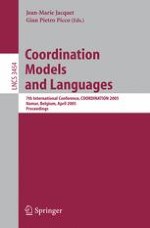2005 | Buch
Coordination Models and Languages
7th International Conference, COORDINATION 2005, Namur, Belgium, April 20-23, 2005. Proceedings
herausgegeben von: Jean-Marie Jacquet, Gian Pietro Picco
Verlag: Springer Berlin Heidelberg
Buchreihe : Lecture Notes in Computer Science
